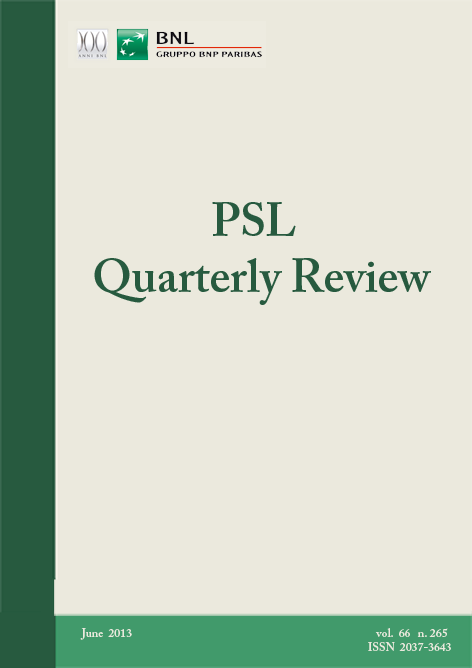A Kaldorian approach to catch up and structural change in economies with high degree of heterogeneity
DOI:
https://doi.org/10.13133/2037-3643/10167Keywords:
structural change, technological progress, industrialization, external restrictionAbstract
This paper, based on Kaldor’s main contributions, discusses the specificities in the catch up process of developing economies with high degree of structural heterogeneity. The theoretical model developed shows that developing economies, when modernizing the domestic versus external stock of capital, can reduce the technological gap and thus obtain a faster growth rate without producing disequilibrium in the balance of payments in the long run. As income distribution explains the incentive to the introduction of innovations through capital accumulation, the model is well succeed in connecting capital accumulation, income distribution, technological gap and long term external constraint. We conclude that capital accumulation, under certain circumstances, can overcome external constraint if the accumulation effort promotes structural change increasing the importance of sectors more technological-intensive.
JEL Codes: O14, O11, F43
References
CIMOLI, M (2005). Heterogeneidad Estructural, Asimetrías Tecnológicas y Crecimiento en América Latina, CEPAL, mimeo.
CIMOLI, M., Primi, A. e Pugno, M. (2006). Un Modelo de Bajo Crecimiento: la informalidad como restricción estructural, Revista de la CEPAL, nº 88, April.
COMMENDATORE, P., D’ACUNTO, S., PANICO, C and PINTO. (2007). A. Keynesian Theories of Growth. In N. Salvatore, ed. The Theories of Economic Growth: a classical perspective, Edward Elgar, Aldershot, pp. 103-138.
DOMAR, E. (1946). Capital Expansion, Rate of Growth and Employment. Econometrica, vol. 14, pp 137-147.
DOSI, G., PAVITT, K., SOETE, L. (1990) The Economics of Technical Change and International Trade, New York University Press.
DUTT, A.K. (2003). Income Elasticity of Imposts, North-South Trade and Uneven Development. In: Dutt, A.K; Ros, J. (orgs.). Development Economics and Structuralist Macroeconomics. Edward Elgar: Aldershot.
FAGERBERG, J. (1988) Why Growth Rates Differ. In: Dosi, G et al. (orgs.). Technical Change and Economic Theory. Pinter Publishers: Londres.
FOLEY, D., MICHL, T. (1999). Growth and Distribution. Harvard University Press: Cambridge (Mass.).
HARROD, R (1939). An Essay in Dynamic Theory. The Economic Journal, vol. 49.
HOLLAND, M., PORCILE, G. (2005). Brecha Tecnológica y Crecimiento en América Latina. In Cimoli, M. (org.) Heterogeneidad estructural, asimetrías tecnológicas y crecimiento en América Latina, CEPAL.
KALDOR, N. (1955-56). Alternative Theories of Distribution, Review of Economics Studies, vol. 23.
KALDOR, N. (1957) A Model of Economic Growth. Economic Journal.
KALDOR, N; MIRRLEES, J.A. (1962). A New Model of Economic Growth. Review of Economic Studies, 29.
KALDOR, N. (1970). The case for regional policies, Scottish Journal of Political Economy,vol.85, pp. 337–348.
LEWIS, A. (2010) O Desenvolvimento Econômico com Oferta Ilimitada de Mão-de-obra.In Agarvala, A.N. e Singh, S.P. (org), A Economia do Subdesenvolvimento, Rio de Janeiro, Contraponto: Centro Internacional Celso Furtado.
MARQUETTI, A. (2004). Do rising Real Wages Increase the Rate of Labor-Saving Technical Change? Some Econometric Evidence. Metroeconomica, vol. 55, no.3.
McCOMBIE, J.S.L., THIRLWALL, A.P (1994). Economic Growth and the Balance-of-Payments Constraint. St Martin’s Press.
McCOMBIE, J.L., ROBERTS, M. (2002). The Role of the Balance of Payments in Economic Growth. In Setterfield, M. The Economics of Demand-led Growth: Challenging the supply-side vision of the long run. Edward Elgar.
MORENO-BRID, J.C. (1998-1999). On Capital Flows and the Balance of Payments Constrained Growth Model. Journal of Post Keynesian Economics, vol. 21, no.2.
RODRIGUEZ, O. (2009). O Estruturalismo Latino-Americano. Civilização Brasileira: Rio de Janeiro.
TARGHETTI, F. (1992). Nicholas Kaldor: the Economics and Politics of Capitalism as a Dynamic System, Claredon Press, Oxford.
THIRWALL, A.P (1979). The Balance of Payments Constraint as an Explanation of International Growth Rates, Banca Nazionale del Lavoro Quarterly Review, March.
VERSPAGEN, B. (1993). Uneven Growth Between Interdependent Economies. Avebury: Aldershot.
Downloads
Published
How to Cite
Issue
Section
License



